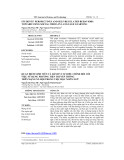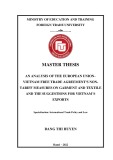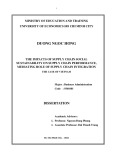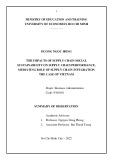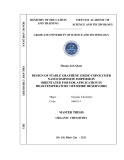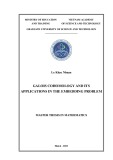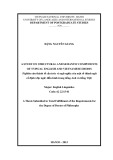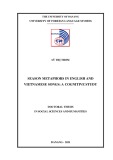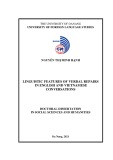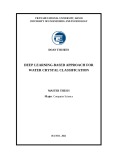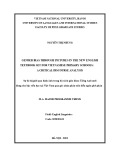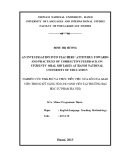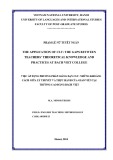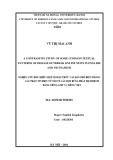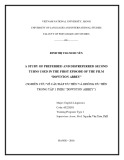VIETNAM NATIONAL UNIVERSITY, HANOI
UNIVERSITY OF LANGUAGES AND INTERNATIONAL STUDIES
FACULTY OF POST-GRADUATE STUDIES
QUÁCH HẢI YẾN
A CRITICAL DISCOURSE ANALYSIS OF AMERICAN
IDEOLOGIES EMBEDDED IN SOME AMERICAN ONLINE NEWS
ON THE CONFLICTS IN THE SOUTH CHINA SEA FROM 2014-2015
PHÂN TÍCH DIỄN NGÔN PHÊ PHÁN VỀ HỆ TƯ TƯỞNG MỸ TRONG CÁC
BẢN TIN ĐIỆN TỬ MỸ VỀ CÁC CUỘC XUNG ĐỘT Ở BIỂN ĐÔNG GIAI ĐOẠN
2014-2015
M.A. MINOR PROGRAMME THESIS
Field: English Linguistics
Code: 8220201.01
HANOI - 2017
VIETNAM NATIONAL UNIVERSITY, HANOI UNIVERSITY OF LANGUAGES AND INTERNATIONAL STUDIES
FACULTY OF POST-GRADUATE STUDIES
QUÁCH HẢI YẾN
A CRITICAL DISCOURSE ANALYSIS OF AMERICAN IDEOLOGIES EMBEDDED IN SOME AMERICAN ONLINE NEWS ON THE CONFLICTS IN THE SOUTH CHINA SEA FROM 2014-2015 PHÂN TÍCH DIỄN NGÔN PHÊ PHÁN VỀ HỆ TƯ TƯỞNG MỸ TRONG CÁC
BẢN TIN ĐIỆN TỬ MỸ VỀ CÁC CUỘC XUNG ĐỘT Ở BIỂN ĐÔNG GIAI ĐOẠN 2014-2015
M.A. MINOR PROGRAMME THESIS
Field: English Linguistics Code: 8220201.01 Supervisor: Dr. Huỳnh Anh Tuấn
HANOI - 2017
I hereby declare that the thesis, entitled “A Critical Discourse Analysis of
DECLARATION
American ideologies embedded in some American online news on the conflicts in
the South China Sea from 2014-2015” has been carried out in partial fulfillment of
the requirements for the degree of Master of Art at the University of Languages and
International Studies. This work is original and all the sources that I have used or
quoted have been indicated and acknowledged by means of complete references.
Hanoi - 2017
Quách Hải Yến
i
ACKNOWLEDGEMENTS
I would like to express my sincere gratitude to my supervisor, Dr. Huynh
Anh Tuan, for his encouragement and support throughout the process of
studying. I have especially appreciated his gentle manner of giving feedback and
the wealth of ideas I have been introduced to over these years.
I would like to give my very special thanks to my friends and the
ii
members of my family who have been supporting me in various ways.
This is a qualitative study that presents the findings of a linguistic analysis
on American online news on the conflicts of the South China Sea from 2014-2015.
The research has applied Fairclough‟s three-dimension framework and Halliday‟s
Systemic functional grammar to identify and explain how American ideologies are
portrayed and represented through language used in the American online news
written by the American reporters. In this research the writer used the descriptive
method to study the problem. There were ten newspapers collected from some well-
known online websites such as CNN, Los Angeles Times, NBC News, New York
Times and Center for Strategic and International Studies. The use of transitivity,
metaphors and negative sentences are analyzed to see how ideologies of the
journalists are embedded in the news. The findings reveal clearly the ideologies of
the American that they are in approval of law-based, equal and anti-hegemonic
policy towards the South China Sea conflicts.
iii
ABSTRACT
LIST OF ABBREVIATIONS
CDA
Abbreviation Meaning
CL
Critical Discourse Analysis
Discourse Analysis
DA
SFG
Systematic Functional Grammar
iv
Critical Linguistics
TABLE OF CONTENTS
DECLARATION ................................................................................................... i
ACKNOWLEDGEMENTS ................................................................................ ii
ABSTRACT ........................................................................................................ iii
LIST OF ABBREVIATION…………………………………….….………….iv
TABLE OF CONTENTS ..................................................................................... v
PART A ................................................................................................................. 1
INTRODUCTION ................................................................................................ 1
1. Rationale of the study ......................................................................................... 1
2. Aim and objectives of the study ......................................................................... 3
3. Research question ............................................................................................... 3
4. Scope of the study .............................................................................................. 3
5. Method of the study ........................................................................................... 3
6. Structure of the study ......................................................................................... 4
PART B.……...…………………………………………………………....…….5
DEVELOPMENT……………………..………………………………..............5
CHAPTER 1 ......................................................................................................... 5
LITERATURE REVIEW .................................................................................... 5
1.1. Discourse analysis ........................................................................................... 5
1.2. Critical Discourse Analysis (CDA) ................................................................. 6
1.2.1. The origin of Critical Discourse Analysis.................................................... 6
1.2.2. The definition of Critical Discourse Analysis.............................................. 7
1.2.3. Critiques to CDA .......................................................................................... 9
1.2.4. The relations of CDA to Power and Ideology............................................ 10
1.3. Michael Halliday‟s systemic functional grammar ....................................... 12
1.4. Norman Fairclough and CDA ....................................................................... 15
v
1.5. A review of related studies ............................................................................ 22
CHAPTER 2 ....................................................................................................... 25
METHODOLOGY ............................................................................................. 25
2.1 Research question ........................................................................................... 25
2.2. Research approach......................................................................................... 25
2.3. Research method ........................................................................................... 26
2.4. Framework of data analysis .......................................................................... 27
CHAPTER 3 ....................................................................................................... 29
FINDINGDS AND DISCUSSIONS .................................................................. 29
3.1. Transitivity analysis ...................................................................................... 29
3.1.1. Mental process............................................................................................ 29
3.1.2. Verbal process ............................................................................................ 30
3.1.3. Relational process ...................................................................................... 32
3.2. Metaphors ...................................................................................................... 34
3.3. Negative sentences ........................................................................................ 35
PART C ............................................................................................................... 36
CONCLUSION ................................................................................................... 36
1. A summary of findings ..................................................................................... 38
2. Limitations and recommendation for further studies ....................................... 40
REFERENCES ................................................................................................... 40
vi
APPENDICES ......................................................................................................I
PART A
INTRODUCTION
This introductory chapter provides a general description of the research
work. It covers the following: research topic, research purpose, research
questions, theoretical background, research strategy, and finally the outline of
the thesis.
1. Rationale of the study
Critical Discourse Analysis (CDA), a recent school of discourse analysis,
is an interdisciplinary approach to the study of discourse, which views “language
as a form of social practice” (Fairclough, 1989). In the modern times, the mass
media such as newspapers, magazines, broadcasts, etc. are playing a vital role in
human life. Media discourse, one of the seven fields of CDA, has become the
primary source of information, which can standardize and control social life and
personal values.
In recent years, the South China Sea‟s conflicts has been a matter of
controversy all around the world, especially in some powerful countries such
America, China and other Asian countries. There are thousands of online news
on this issue produced every day and they can be found in numerous websites.
This study is based on the analytic paradigm of Critical Discourse
Analysis (CDA) described by Fairclough (1989, 1992, 1995a, 1995b), and
Systemic Functional Grammar (SFG) to analyse the data to find out the
American ideologies through the discourse.
O‟Halloran (2003, p.1), views the Critical Discourse Analysis (CDA) as
a branch of linguistics that specifically searches and identifies the traces of
cultural and ideological meaning in spoken and written language; while Parker
(1992, p.5) looks at discourse in general as a system of statements which
1
constructs an object. A lot of work on discourse analysis has been carried out by
a number of experts in the field. The quest for gaining a clear understanding of
the meaning behind some speeches both written and spoken, has given rise to
CDA. Often times, some speeches and news texts are masked in secrecy and
listeners can sometimes struggle to understand the meaning behind the spoken
words. CDA provides a good platform for explaining spoken and written
language.
Moreover, CDA uses a number of techniques to resolve the meaning of
some texts. The 21st century society is now immersed with a lot of information
coming from the news media and coming from different kinds of people equally
serving a variety of purposes. In order to understand the true nature of news
reports, namely the social and power relationship, the hidden ideologies, and the
way they present people and issues, it is necessary to employ CDA.
Tensions between China and Vietnam over the disputed South China Sea
are at their highest levels in years. On May 2, 2014, the state-owned China
National Offshore Oil Corporation (CNOOC) placed its deep sea drilling rig
HD-981 in disputed waters south of the Paracel Islands. Vietnam objected to the
placement, declaring that the rig is located on its continental shelf. China has
since sent approximately 80 ships, including seven military vessels, along with
aircraft to support the rig. In response, Hanoi dispatched 29 ships to attempt to
disrupt the rig‟s placement and operations. The situation escalated dramatically
on May 7, when Vietnam accused Chinese vessels of turning high powered
water cannons on the Vietnamese ships and eventually ramming several vessels.
The implications of these developments are significant. However, few attempts
have so far been made to analyze language use in online news related to this
topic. Therefore, under the light of CDA the writer will attempt to unravel the
American ideologies behind the American online news and what exactly the
2
writers were trying to say about the conflicts on the South China Sea.
2. Aim and objectives of the study
The study aims to:
Investigate American ideologies embedded in some American online
news on the conflicts in the South China Sea from 2014-2015.
readers: to develop the ability of critical thinking when they read a
text.
Raise a critical awareness for the language learners and newspaper
The following objective is set to accomplish the aim:
Explore the American reporters‟ underlying ideologies through
analyzing the linguistic features of the news reports, which also present
the close link between ideologies and media language.
3. Research question
In accordance with the objectives of the study, the research is conducted
to find out answers to the following research question:
What are American ideologies on the issue of the South China Sea conflicts
hidden in the linguistic expressions?
4. Scope of the study
In this study, the writer would focus on the online news reported on the
South China Sea conflicts from 2014 to 2015. The writer acknowledges that the
more extensive the scope of information accomplished, the more dependable the
study results will be. However, due to the constraint of time and the limited
length of a minor thesis, in this study, only ten online news reports were tested,
which came from CNN, Los Angeles Times, NBC News, New York Times and
Center for Strategic and International Studies. This minor thesis does not express
the writer‟s opinions related to political issues to change the readers‟ thoughts. In
fact, it is entirely served for scholastic goal.
5. Method of the study
3
The methodological approach is built totally on the foundation of
discourse analysis. The research method involves a qualitative content analysis.
Within this area of investigation, the three dimension model given by Fairclough
(2001) will be combined with Halliday‟s Systemic functional grammar to
analyze the news.
6. Structure of the study
The organization of this thesis is presented as follows.
Part A: Introduction
This part presents an overview of the research in which the rationale, the
aims, the research questions, the scope as well as the organization are shortly
expressed.
Part B: Development
Chapter 1: Literature Review (This section provides basic concepts,
theoretical framework and related research of the study).
Chapter 2: Research Methodology (This part presents a detailed
description of methodological choices for the study: data collection procedures
and data analysis procedures.)
Chapter 3: Findings and Discussion (This sector gives the findings and
discussions of the study).
Part C: Conclusion
The last part summaries the study, gives some conclusion points to the
study, and discusses the limitations of the study as well as suggestions for further
4
research.
PART B
DEVELOPMENT
CHAPTER 1
LITERATURE REVIEW
1.1. Discourse analysis
Van Dijk, T.A. (1998) states discourse analysis (DA), or discourse studies,
is a general term for a number of approaches to analyze written, vocal, or sign
language use, or any significant semiotic event.
The objects of discourse analysis (discourse, writing, conversation,
communicative event) are variously defined in terms of coherent sequences of
sentences, propositions, speech, or turns-at-talk. Contrary to much of traditional
linguistics, discourse analysts not only study language use 'beyond the sentence
boundary' but also prefer to analyze “naturally occurring” language use, not
invented examples. Text linguistics is a closely related field. The essential
difference between discourse analysis and text linguistics is that discourse
analysis aims at revealing socio-psychological characteristics of a person/persons
rather than text structure.
Discourse analysis has been taken up in a variety of disciplines in the
humanities and social sciences, including linguistics, education, sociology,
anthropology, social work, cognitive psychology, social psychology, area
studies, cultural studies, international relations, human geography,
communication studies, biblical studies, and translation studies, each of which is
subject to its own assumptions, dimensions of analysis, and methodologies.
The various levels or dimensions of discourse, such as sounds (intonation,
Topics of discourse analysis include:
etc.), gestures, syntax, the lexicon, style, rhetoric, meanings, speech acts,
5
moves, strategies, turns, and other aspects of interaction
Genres of discourse (various types of discourse in politics, the media,
The relations between discourse and the emergence of syntactic structure
The relations between text (discourse) and context
The relations between discourse and power
The relations between discourse and interaction
The relations between discourse and cognition and memory
education, science, business, etc.)
1.2. Critical discourse analysis (CDA)
1.2.1. The origin of Critical Discourse Analysis
Critical Linguistics (CL) arouse in the mid-1970s as a necessity for an
academic branch which would examine the connections between language and
ideology, social structure. CL was theoretically affected by the Critical Theory
of the Frankfurt school and by the Marxist philosophy. Roger Fowler, Tony
Trew and Gunther Kress were the pioneers of CL and their explicit argument
was that: “the world-view comes to language-users from their relation to
institutions and the socio -economic structure of their society. It is facilitated and
confirmed for them by a language use which has society‟s ideological impress.
Similarly, ideology is linguistically mediated […]” (Fowler, Kress 1979: 185).
This argument presented the need for a linguistic analysis which would
not only be formal or neutral, as Fowler and Kress put it, but also critical. “The
need then is for a linguistics which is critical, which is aware of the assumptions
on which it is based and prepared to reflect critically the underlying cause of the
phenomena it studies, and the nature of the society whose language it is. (1979:
186)”
The systemic functionalist linguistics was where CL relied for an
analytical framework. M. A. K. Halliday‟s books Language as Social Semiotic
(1978) and Introduction to Functional Grammar (1985) were central to Critical
6
Linguistic Analyses. The concepts of these books became important for
understanding grammar and interpreting texts, keeping in mind that: “grammar
has to interface with what goes on outside language: with the happenings and
conditions of the world, and with the social processes we engage in” (Halliday
2004: 24)
Halliday's Systemic Functional Linguistics became the groundwork to
establish three basic assumptions for CL: “that language serves a number of
specific functions, and that all linguistic forms and processes express one or all
these functions; 2 that the selections which speakers make from among the total
inventory of forms and processes are principled and systematic; and 3 that the
relation between form and content is not arbitrary or conventional, but that form
signifies content.” (Fowler, Kress 1979: 185)
Moreover Halliday‟s Functionalist Grammar was the foreground of an
analytic method, or the linguistic toolkit to CL, but not only to them. It still
seems to be very important even to do and understand CL descendant: Critical
Discourse Analysis. “In most studies there is reference to Hallidayan systemic
functional grammar. This indicates that an understanding of the basic claims of
Halliday's grammar and his approach to linguistic analysis is essential for a
proper understanding of CDA.” (Wodak and Meyer 2002: 8)
1.2.2. The definition of Critical Discourse Analysis (CDA)
According to Van Dijk, discourse has three main domains: “(a) language
use, (b) the communication of beliefs (cognition), and (c) interaction in the social
situation”. (Van Dijk 1997a:2) The coexistence of these domains urges the
necessity to analyze discourse from a multidisciplinary perspective.
In the beginning of 1990s a new school of thought arose, aiming to
analyze the discourse through a multidisciplinary approach. This school
established a new paradigm in Discourse Analysis, that of Critical Discourse
Analysis (CDA).
7
CDA can be described as „a type of discourse analytical research that
primarily studies the way social power abuse, dominance and inequality are
enacted, reproduced and resisted by text and talk in the social and political
context‟(O‟Halloran,2003,p.11). CDA is historically interested in the
examination of news texts for language manipulation. This has allowed much of
the current research on CDA to also focus on news texts in an effort to find
language manipulation. However, there are a sizeable number of researchers who
use CDA to interpret the meaning of speeches given by modern day politicians
and other interesting personalities. Politicians are notorious for manipulating
language for their own benefit. The ordinary man may be misled by some of the
speeches given by these politicians and CDA endeavours to unravel the hidden
meaning behind some of these speeches (O‟Halloran, 2003, p.3).
Furthermore, CDA is characterised by a number of common elements
namely; its ability to address social problems, the discursive nature of power
relations, the relationship between discourse, society and culture, how discourse
is historical and how it performs ideological work; and how discourse is a form
of social action. All these elements are present in our everyday lives
(O‟Halloran, 2003, p.16).
O‟Halloran (2003) suggests that mystification is embedded within
CDA and suggests a few concepts in mystification analysis. These include
"transitivity; which deals with the grammatical meaning of words in a clause,
ideal passivisation; which can help create a distance impression between the
writer and the reader and ideal normalisation; which refers to the process where
a verb is changed into a noun" (pp. 17-18).
In addition, Wodak et al., (2001, p.2) uses Critical Linguistics and
CDA interchangeably and many other experts in linguistics do the same. They
further advise that the purpose of CDA is to "critically investigate social
inequality as it is expressed, signalled, constituted and legitimised" (Wodak et
8
al., 2001, p.2). A review of the available literature on CDA largely supports this
concept. However, it is not rooted in any one particular theory. It encompasses
theoretical concepts from a variety of researchers (Wodak et al., 2001, p.18).
Van Leeuwen (2008) makes use of a number of modern tools in CDA.
Nonetheless, most of these tools are a combination of theories and frameworks
from past work on discourse analysis.
1.2.3. Critiques to CDA
CDA has continuously been criticized for having theoretical shaky
grounds, for the lack of scientific methods and for the way analyses are
undertaken. Edward Haig makes a remarkable statement regarding the large
number of the critics of CDA, whose activity “threatens to develop into a whole
new academic cottage industry of its own” (2014: 5).
The work of Critical Discourse Analysts is criticized for offering a single
plausible interpretation and for claiming that the more detailed the analysis, the
more convincing the interpretation will be. Henry Widdowson (1998), one of the
faultfinders of CDA argues that the principles of analysis are unclear. To add
Widdowson claims that the analyses is biased and to some extent arbitrary, as it
does not take into account the standpoints of the writers or the readers of the
texts. “The producers and consumers of texts are never consulted. Thus, no
attempt is ever made to establish empirically what writers might have intended
by their texts. Their intentions are vicariously inferred from the analysis itself, by
reference to what the analyst assumes in advance to be the writer's ideological
position. Nor is there any consultation with the readers for whom texts are
designed. Their understanding is assigned to them by proxy, which in effect
means that the analysts use the linguistic features of the text selectively to
confirm their own prejudice” (Widdowson 1998: 143). The matter of a single
plausible interpretation is also related to the levels of adequacy of CDA. While
its faultfinders argue that the discourse analysis can at its best reach an
9
interpretative adequacy, the critical discourse analysts and theorists disagree.
According to them the range 20 of possible interpretations can be narrowed
down by deconstructing the text and discovering the ideologies and power
relations embedded in it. Fairclough and Wodak (1997) emphasize the fact that
CDA can reach an explanatory adequacy: This marks the point where critical
readings differ from reading by an uncritical audience: they differ in their
systematic approach to inherent meanings, they rely on scientific procedures and
they naturally and necessarily require self-reflection of the researchers
themselves. In this point, they differ clearly from pure hermeneutics. We might
say they are explanatory in intent, not just interpretative. We also have to state
that interpretations are never finished and authoritative; they are dynamic and
open, open to new contexts and new information (Fairclough, Wodak 1997:
279). Besides these objections toward CDA, another central critique is that of
analysts having partial or political stances, which effect their interpretations.
Although this claim accuses CDA researchers for being biased and subjective,
they do not oppose it. Having such a stance does not make CDA less scientific.
“Unlike much other scholarship, CDA does not deny but explicitly defines and
defends its own sociopolitical position. That is, CDA is biased – and proud of it”
(Wodak, Meyer 2001: 96). In conclusion the critique towards CDA has been
addressed by Critical Discourse analysts themselves. In this study the PDA aims
to consider what is more trustworthy from the discipline of CDA, to understand
the way politicians talk. As we are convinced that the linguistic features of the
political discourse cannot be considered simply stylistic expressions or
preferences. Wodak and Meyer (2001) emphasize that CDA analysts do
“discourse analysis with an attitude”, and they are in “solidarity with the
oppressed ones” (96).
1.2.4. The relations of CDA to Power and Ideology
The word “critical” is a key theoretical concept in CDA that requires
10
some explanation here. “Critical” indicates the need for analysts to decode the
ideological implications of discourse that have become so naturalized over time
that we begin to treat them as common, acceptable, and natural features of
discourse. That is, ideology has become common belief or even common sense.
Adapting “critical” approach enables us to “elucidate such naturalizations, and
make clear social determinations and effects of discourse which are
characteristically opaque to participants” (Fairclough, 1985, p. 739).
Ideology plays a vital role in CDA. According to Wodak (1996),
“ideologies are particular ways of representing and constructing society which
reproduce unequal relations of power, relations of domination and exploitation”
(p. 18). Fairclough (1992) explains ideology as “an accumulated and naturalized
orientation which is built into norms and conventions, as well as an ongoing
work to naturalize and denaturalize such orientations in discursive events” (p.
89). For Widdowson (1990), “all discourses of theory, including those of
linguistics, are ideologically loaded” (p. 39). Newspapers, which claim to be
politically neutral and ideology free, have to choose their discursive
representations in line with their institutional policies which are ideological
themselves because they are not nameless and neutral but have a history and a
politics (Cameron, 1993, p. 316).
Power in CDA is everywhere and no language in use can ever be 'neutral'
or 'objective' (Fairclough, 1989) and no discourse can ever be free of power and
the exercise of power (Watts, 1992). Power is not derived from language, but
language can be used to challenge power, to provide a finely articulated means
for differences in power in social hierarchical structures. Language is not
powerful on its own, but gains power by the use powerful people make of it as
Deborah Cameron (2001) (in Muralikrishnan 2011, p.23) says, "words can be
powerful: the institutional authority to categorize people is frequently
inseparable from the authority to do things to them”. Following Cameron (2001),
11
Muralikrishnan (2011) pointed out that a great deal of power and social control
in the modern age is exercised not by brute physical force or even by economic
coercion, but by the activities of "experts" who are licensed to define, describe
and classify things and people. Fairclough (1995) argued that power can be
conceptualized both in terms of asymmetries between participants in discourse
events, and in terms of unequal capacity to control how texts are produced,
distributed and consumed in particular social contexts. This type of power
mainly stems from ideology, the knowledge that enables persons or groups to
carry out their will, or to influence others in spite of their resistance (Andersen,
1988; Fairclough, 1989).
1.3. Michael halliday’s systemic functional grammar
Systemic functional grammar (SFG) is an approach to language
developed mainly by Michael Halliday in the U.K. during the 1960s. It is the
part of a broad social semiotic approach to language called systemic functional
linguistics. The term “systemic” means “a network of systems, or interrelated
sets of options for making meaning”. The term “functional” tells us that the
approach focuses on meaning rather than formal grammar.
SFG explains how the language is used. According to Halliday, 1994:
xiv, SFG is a lexico-grammatical theory grounds upon the notion of choice
where language and/or any other semiotic system for that matter, is interpreted
as “networks of interlocking options”. In other words, SFG is concerned
primarily with the choices the grammar makes available to the speakers and
writers. These choices relate speakers‟ and writers‟ intentions to the concrete
forms of a language. Grammar choices are viewed in terms of either the content
or the structure of the language used. In SFG, language is analyzed in three
different strata: semantics, phonology and lexico-grammar. SFG presents a view
of language in terms of both structure (grammar) and words (lexis), and “lexico
grammar” describes this combined approach. In more detail, Halliday's SFG
12
consists of three metafunctions: textual, interpersonal, and ideational. All three
metafunctions contribute to the meaning of what is said but are usually
represented by different parts of the message (Thompson 2004: 30). While the
ideational metafunction embodies the world of experience; the interpersonal
metafuntion sets up language as a medium through which interactional meaning
such as attitudes, judgements and feelings are expressed; and the last one, the
textual metafunction looks at how the information is ordered, organized and
presented.
The ideational metafunction
Transitivity is a key analytic component to examine the ideational
metafunction of language. Transitivity includes six types of process: Material,
Mental, Relational, Behavioral, Verbal and Existential. The table 1 below
presents a summary of these process types:
Summary of process types (adapted from Halliday, 1994: 143)
Participants Example
Process type
Category meaning
Definition
'doing'
Actor, Goal
1. Material
that
Processes of doing the things; express some notion does entity something, which may be done “to” some other entity
Action
'doing'
'happening'
Event
The boy hit the dog The mayor resigned
'behaving'
2. Behavioral
Behaver, Phenomenon
He stared at me
of human) and
Processes (typically physiological psychological behavior like breathing, coughing, dreaming, staring
13
'sensing'
3. Mental
Senser, Phenomenon
A kind of activity in people‟s mind, requires a conscious participant
'seeing'
hadn‟t
Perception
Affection
'feeling'
I noticed that The boy loved the girl
Cognition
'thinking'
She didn‟t believe her husband
Processes of saying
4. Verbal
'saying'
John told me the truth
Sayer, Target, Recipient
„being‟
at‟
5. Relational
Processes of „being‟, „being and „having‟
Attribution
„attributing‟
She is kind- hearted
Carrier, Attribute
is
the
Identification
„identifying‟
Tom leader
Possession
„having‟
a
Identified, Identifier; Token, Value Possessor, possessed
I have daughter
„existing‟
Existent
6. Existential
There was a storm
Processes of „existing‟ or „happening‟
The interpersonal metafunction
The interpersonal metafunction consists of language features aimed at
interacting with others. These features include asking for and providing
information and expressing attitudes (which involve the mood structure of
14
English (i.e. whether the clause is a declarative or interrogative clause, for
example).
In other words, this metafunction relates to a text's aspects of tenor or
interactivity. Like field, tenor comprises three component areas: the
speaker/writer persona, social distance, and relative social status. Social distance
and relative social status are applicable only to spoken texts. The speaker/writer
persona concerns the stance, personalization and standing of the speaker or
writer. This involves looking at whether the writer or speaker has a neutral
attitude, which can be seen through the use of positive or negative language.
Social distance means how close the speakers are, e.g. how the use of nicknames
shows the degree to which they are intimate. Relative social status asks whether
they are equal in terms of power and knowledge on a subject, for example, the
relationship between a mother and child would be considered unequal. Focuses
here are on speech acts (e.g. whether one person tends to ask questions and the
other speaker tends to answer), who chooses the topic, turn management, and
how capable both speakers are of evaluating the subject.
The textual metafunction
The textual metafunction is concerned with the organization of the
message (Halliday and Matthiessen 2004: 30) and is realized in texts through
features such as cohesion (e.g. ellipsis, substitution, lexical cohesion) and
thematic structure.
In short, CDA and SFL have a common interest in the link between
language and society. CDA uses SFL as a tool to analyze texts and discourses.
SFL is of special interest to CDA, mainly due to its focus on language use, its
informative and social functions. Other linguistic models are also useful to CDA
but they may lack strong attraction to CDA analysts due to their emphasis on
syntactic structure and less on functional aspects of language. SFG is now used
world-wide, particularly in language education, and for purposes of discourse
analysis.
15
1.4. Norman Fairclough and CDA
Within the CDA field, one of the most dominant approaches for
analyzing discourse was developed by Fairclough in the 1980s and it has been
revisited in several publications thereafter. Fairclough's method is based on the
formulation that the way people produce and interpret language is ultimately
affected and controlled by power. Fairclough explains it through the following
process: the way people produce and interpret language is affected by their
experiences of the world, and experiences are affected by social organization,
which, in turn, is affected and controlled by power (1989: 25). To paraphrase,
power dictates to a considerable degree how the world works (e.g. the news is
shaped by commercialism and corporate interests), which, in turn, affects what
kinds of experiences (e.g. the experience of what reading news articles is like),
and the experiences affect aspects of language use (e.g. which point of view of
an event is prominent in everyday discussions). Therefore, in order to analyze
texts, one must analyze "the relationship between texts, processes, and their
social conditions [i.e.] the situational context and institutional and social
structures". This three-layer view of discourse is at the core of Fairclough's
three-dimensional model. The following quote summarizes the model in the
most concise and explicit manner:
I see discourse as a complex of three elements: social practice,
discoursal practice (text production, distribution and consumption), and text,
and the analysis of a specific discourse calls for analysis in each of these three
dimensions and their interrelations. The hypothesis is that significant
connections exist between features of texts, ways in which texts are put together
Fairclough 1995: 74
and interpreted, and the nature of the social practice.
In other words, Fairclough's model of CDA divides discourse into three
distinct aspects: the physical text (spoken or written), the discourse practice, and
16
the social practice. Furthermore, Fairclough stresses the importance of analyzing
how these three levels affect one another within any given discourse. The model,
therefore, provides a complex framework for analyzing various aspects of
discourse and language use.
Text (Description)
The first level of analysis consists of the text itself. This level concerns,
for example, the grammatical (e.g. modality and transitivity; Fairclough 1995:
134) and lexical choices of the writer (e.g. metaphors and synonyms; Blommaert
and Bulcaen 2000:448). For Fairclough (1989: 26), "Description is the stage
which is concerned with formal properties of text”. In other words, linguistic
features of the text are to be explored in the descriptive stage. For the purpose
that they can be understood more clearly, he also posts ten key questions
together with more other sub-questions, which mainly involved vocabulary
section, grammar section, and textual structures section (Fairclough, 1989). The
section of vocabulary mainly deals with the choice of different words; grammar
is about the grammatical features, which has a close relation with Halliday's
systemic-functional grammar whereas the textual structures part concerns the
whole structures of the discourse.
Discursive Practice (Interpretation)
Fairclough (1989) says "interpretation is concerned with the relationship
between text and interaction with seeing the text as the product of a process of
production, and as recourse in the process of interpretation" (p.26). In the
interpretation stage, the relationship between the discourse and its production
and its consumption should be interpreted. Besides, discourse is not only
regarded as text but also a discursive practice in this stage, which means apart
from analyzing linguistic features and text structure, attention should be drawn to
other factors such as speech act and intertextuality. These factors link the text to
its context.
17
This dimension (text as discursive practice) includes two processes. One
is institutional process (editorial procedure), and the other is discourse process
(the alteration that the text goes through in production and consumption). Here,
the key concept "intertextuality" is highly conducive to explain the discourse
process. In other words, this step deals with the exploration of inter-textual
relations among discourse, texts and setting. That is, the discourse should not
only be considered as the linguistic version, but also a kind of discursive
practice. Those factors which relate to how people produce and interpret the
news discourse should be taken into consideration, thereby, the news source and
reporting modes should be worthy of exploration in the interpretive stage of
news reports (Fairclough, 1995).
Social Practice (Explanation)
According to Fairclough (1989: 26), "Explanation is concerned with the
relationship between interaction and social context with the social determination
of the process of production and interpretation, and their social effects". On the
other hand, the analysis in explanative part is in reference to the historical,
social, and cultural contexts. Since news discourse can be considered as a kind of
social practice, sociality and institution in fact, exert huge influence on news
reports. In discourse analysis, especially news reports, the undiscovered
information of power, ideology and language will be investigated and explained
in this part by two contexts, institutional context and societal context
(Fairclough, 1995). The explanation stage corresponds to the dimension
"discourse as social practice," more precisely "socialcultural practice." In this
stage, factors like ideology or power are taken into account so as to fully explain
the interaction between social-cultural context and the production and
consumption of texts.
As a matter of fact, the three steps are closely related with each other none
of them are indispensable. With the three successive steps united together, the
18
hidden knowledge of linguistic, inter-textual and social factors can be exposited
in the analysis of the news discourse. A detail and specific exploration of the
news discourse will be conducted so as to find out the ways used by Trump in
delivering his political speech.
In short, Fairclough subsequently gives three stages of CDA, which are
in accord with the three mentioned above levels of discourse:
● Description is the stage which is concerned with the formal properties
of the text.
● Interpretation is concerned with the relationship between text and
interaction with seeing the text as a product of a process of production, and as a
resource in the process of interpretation…
● Explanation is concerned with the relationship between interaction and
social context with the social determination of the processes of production and
interpretation, and their social effects.
(Fairclough 1989: 26)
Fairclough's three-dimensional framework for analysis of discourse
19
A framework for Critical Discourse Analysis of a communicative event
(Extracted from Fairclough 1995: 59)
text production
Text
text consumption
discourse practice
sociocultural practice
Fairclough takes a multifunctional view of text and suggests that in
analyzing a sentence in a written text, for example, the analyst may concentrate
on how the three main categories of function (ideational, interpersonal and
textual) are expressed:
particular representations and recontextualizations of social practice
(this is the ideational function of the sentence and may carry
particular ideologies)
particular constructions of writer and reader identities (for instance, in
terms of what is highlighted)
a particular construction of the relationship between writer and reader
(for example, formal or informal; close or distant)
He further suggests that the analysis of any text is dependent on the
existence of these three main categories. In media discourse analysis like in the
case of press and television, to see how meanings are produced, beside language
analysis, other semiotic mediums such as photographic images, layout and the
20
overall visual organization of pages, film and sounds effects need to be analyzed.
In the text analysis level, several questions are listed to guide:
1. How are words used to show ideology?
2. What patterns of transitivity - grammatical processes and participants - are
found? Considering material processes, are Actors (agents) inanimate or
animate, and if the later, what kinds of individuals? Similarly for Affected
and beneficiary. And again the same questions with reference to
Relational processes, Mental Processes and Verbal processes. This reveals
a lot about agency, who does what to whom (Affected) or is the action not
directed toward an Affected party? What kinds of entity are shown as
having existence or being in a certain state or entering into a relationship?
3. Passives - is this used to delete agency and is there an ideological
function?
4. Nominalization - what processes are converted into nouns, and what is the
effect (absence of both participants)
5. Choices of mood - how does the sentence form - declarative,
interrogative, and imperative - position the subjects?
6. Choices of modality - how do they reflect relational and expressive
values? Modal verbs like may, might, must, should, can, and their
negatives all express values relating to the authority of one participant, or
degrees of certainty, or the evaluation of truth or capability. Claims to
knowledge have an important ideological function.
7. Thematic structure - the choice of entity to fill theme position in the
clause (initial position) is important in signaling what a text is considered
to be about. Such an entity is automatically fore grounded.
8. Speech acts - who is represented as asking questions, making requests,
giving undertakings of various kinds, giving orders, etc. Also, what
strategies of directness are employed in the performance of these and
21
other speech acts. This can tell much about social relationships.
9. Presuppositions - there are many types of this but the basic idea that it is
an assumption made by a speaker or writer which is not explicitly stated.
1.5. A review of related studies
One might say that Teun Van Dijk is one of the greatest contributors in
the area of press new discourse analysis. In his initial work (1983), he discusses
the improvement and utilization of discourse analysis to the news structure. He
also presents that news discourse in the daily press can be described
systematically and explicitly on the basis of results of text linguistics and
discourse analysis. In the 1980s, Van Dijk builded up „social-cognitive‟ model in
discourse analysis. He stated an analytical framework for analyzing news. This
framework analyses news texts in terms of what he calls 'the structures of news',
processes of news production, processes of news comprehension. The analysis
demonstrated connections between texts, production processes and
comprehension processes, and the social practices they are embedded within.
Based on the models of Herman and Chomsky (1988), Harley (1982) and van
Dijk (1988) in CDA, Craig and Lee (1992) compared the US coverage of South
Korea labor strikes with that of Polish labor strikes with the purpose of
discerning the ideological framework of US international political reportage. The
examination of US news coverage of the social structural issue reveals that the
news represented labor disputes in South Korea and Poland within the 'us vs.
them', anti-communist framework. Although a similar issue was at stake: South
Korea and Polish workers were striking against their ruling system for
democratization, including the right to form independent unions, very different
orientations were taken to the striking workers in each country. First, in South
Korean labour dispute, US mainstream newspapers paid less attention to the
issue and demands of the strikers, most of the strike coverage appeared inside the
newspaper. By contrast, Polish labour strikes consistently gained front page
22
attention from US newspapers, news stories related the strikes to the 'crisis' of
the whole Polish system. At the textual level, depending on the country, news
accounts of similar events had different news framework, different propositions,
different ordering of propositions. In short, US news coverage of labor disputes
is motivated by ideological and political opportunism.
Teo (2000) examined two Sydney newspapers (The Sydney Morning
Herald and The Daily Telegraph) can be used as instrument to exert ideological
dominance on recent Asian migrants into Australia. The study focuses on news
reports about a gang of young Vietnamese drug-dealers Sydney. Through the
analysis of lexical choice and syntactic structure of the newspaper headlines and
leads, Teo concluded that the two newspapers' ways of reporting the event
unravel an ideology that depicts the police in a position of power and control
while the minority 5T is consistently associated with crime and mayhem. In
other words, there is lexical and structural evidence of positive US-presentation
and negative Them-presentation in the news headlines. In addition, by analysis
of the quotation patterns and information sources he found that there was an
over-whelming disproportion of white majority voice against ethnic minority
voice. To unravel the sort of ideological structures that are embedded within the
newspaper discourse further, Teo also provided a detailed structural analysis of
two texts of the two newspapers. By focusing on three aspects of Halliday's
Systemic Functional Grammar, namely, 'transitivity', 'thematization' and 'lexical
cohesion', he concludes that there exists a stark contrast between the ways the 5T
and the police are portrayed. Besides, by examining more deeply into the
workings of the media industry, social psychology and the socio-political forces
shaping contemporary Australia, Teo explained why there is the dichotomization
of the police and the 5T and why newspapers present news in the ways they do.
Different from other mentioning above researchers on the topic of
language and ideology in news reporting which studied either international or
23
domestic coverage, Pan, X. (2002) taking a mutil-perspective view examined
both international and domestic reportage of the right of adobe issue in post
colonial Hong Kong. Four elite newspapers are targeted for analysis: China
Daily from the People's Republic of China, The New York Times from the USA,
South China Morning Post from Hong Kong and The Times of the UK. The
analysis of lexical choices, propositions as well as corpus analysis reveal that the
dissimilar coverage of the same issue denoted the various points of view held by
the individual newspapers, which are rooted in their political beliefs, cultural
assumptions and institutional practices. In other words, the different coverage is
in line with the media's own ideological stances.
In conclusion, through a glimpse of studies on news discourse analysis,
we can notice that that news discourse has been a popular discourse for a long
time. Researchers on this field either provide theories for analyzing news
discourse (Van Dijk 1983, 1985, 1988) or examine different discourse strategies
used by various newspapers' reports of a wide range of social issues in different
languages. In spite of being diverse in their methods of analysis, the reviewed
studies are uniform in exploring only newspapers of some mentioned big
countries. However, none of them have ever done any researches on American
ideologies through political online news. Therefore, the researcher hopes that by
analyzing the American online news from some famous American websites will
achieve her aim of discovering the ideologies of American people through the
24
conflicts in the South China Sea.
CHAPTER 2
METHODOLOGY
This chapter outlines a systematic way of how the research problem is
solved. To be more specific, it explains how the methods of research design, data
collection and analysis best fit the research question. In addition, this section
represents the reliability and validity of the study.
2.1 Research question
The present study attempts to address the following research question:
What are American ideologies on the issue of the South China Sea
conflicts hidden in the linguistic expressions?
2.2. Research approach
Qualitative research
Research approaches refer to plans and procedures for research that
describe which steps to take in collecting, analyzing, and interpreting data
(Creswell 2014, pp. 3-4). A research approach is selected based on the nature of
the research problem or issue being addressed, as well as the audience for the
study that accept the research. The research problem of this study calls for a
qualitative research design that allows an in-depth analysis and closer look of the
processes and meanings which cannot be measured in quantity or frequency.
Generally, a qualitative research can be distinguished from another type of
research design called quantitative research by looking at the basic philosophical
assumptions researchers bring to study, the types of strategies used, and the
specific methods employed in conducting these strategies (National Science
Foundation).
A qualitative research design is used in this study because it provides
basis and tools for exploring, understanding and interpreting social, political and
25
human phenomena. Given the nature of the research problem of this study,
qualitative research provides a more realistic feeling and views of the world,
events, actions or policies that cannot be experienced in any numerical or
statistical data.
This study collects and analyzes data on politicians‟ and reporters‟
written text. And because these is information that anyone could easily relate to
than numerical ones, the extent of interpretation is greater. Furthermore, with the
use of qualitative research, it is easy to understand the aim of one‟s action by
being exploratory in interpreting them through triangulation and to relay the
message of such action with the use of senses. Qualitative research allows
researchers to investigate selections of cases through observation, interviews,
case studies, and discourse analysis (Berg & Lune 2012, pp. 11-14).
2.3. Research method
By using news websites, the researcher ran a research for the written texts
in which American ideologies phrases are presented in conjunction with news on
the conflicts in the South China Sea.
With the purpose of discerning the underlying ideologies of the reporters,
Fairclough‟s three-dimensional approach to CDA is applied to analyze the news.
Qualitative method is used in the study. Three stages proposed by Fairclough
(2001), namely description, interpretation and explanation are intertwined in the
thesis, instead of being given separately to show the direct link of each step. To
be specific, each formal property of the news at textual analysis is in direct
relation with the ideologies of the reporters. As Fairclough emphasized that his
proposed procedure of doing CDA should not be considered a blueprint, but just
a guide with which depending on the research purposes, some aspects should be
taken into consideration. Accordingly, in details, based on Fairclough‟s model of
ten questions to find out the formal properties of the texts, the researcher just
focuses on some linguistic features to see how ideologies of the journalists are
26
encoded through language choices. With regard to grammatical analysis,
transitivity and negative sentences are scrutinized. In terms of lexical choice,
metaphors are analyzed.
2.4. Framework of data analysis
The theoretical framework used for this study is based on Norman
Fairclough‟s Critical Discourse Analysis (CDA) framework. This framework
was first conceptualised to study the connection between the use of language and
through it, the assertion of power (Fairclough 1989). Later, Fairclough redefined
his CDA framework to specifically use it as a tool to analyze media texts.
The analytical framework is presented as below:
Mental process
Transitivity
Verbal process
Metaphors
Relational process
American ideologies
Qualita tive analysis
Negative sentences
Description
Interpretation
Explanation
27
In the descriptive stage, the use of transitivity, metaphors and negative
sentences are analyzed to see how ideologies of the journalists are embedded in
the news.
In the next stage – interpretation, context is considered. For interpreting
situational context, questions given by Fairclough (2001) are utilized as useful
suggestions: What is going on?, Who is involved?, What relationships are at
issue?, What is the role of langue in what is going on?
Finally, in the last stage – explanation, the relationship between
interaction and social context is mentioned in order to see how the discourse
production and interpretation are determined by social structures and what
28
effects the discourse can have on those structures.
CHAPTER 3
FINDINGS AND DISCUSSIONS
This chapter presents the gathered findings of the present study involving
ten American online news.
3.1. Transitivity analysis
3.1.1. Mental process
Mental processes encode the meanings of feeling or thinking. They are
internalized processes, in contrast to the externalized processes of doing and
speaking. Halliday and Matthiessen (2004) observe that, unlike material
processes, mental processes always involve at least one human participant who
has the mind in which the process occurs. They involve the human senses -
perception, affection, and cognition. They entail the processes of encoding
meanings of thinking, feeling, perceiving or desiring. These are processes of
sensing, thinking, feeling and perceiving, having Sensor and Phenomenon.
Sensor is the person who senses, Phenomenon is the object involved in the
process. It is the entity which is felt, thought, or perceived by the sensor.
In analyzing the online news, the researcher has found out that the mental
process used really makes the reader knows more about the ideology of
American people about the issue of the South China Sea conflicts. The verbs
“fears”, “concerned” are used mainly to express the real thoughts of the
American government when seeing China‟s actions in expanding their power in
the South China Sea.
(1) Obama fears China is bullying South China Sea neighbors
(nbcnews.com)
Here we can see that Obama is the Senser with his feeling of worried of
the countries which involved in the South China Sea dispute are bullied by
China. The word “bully” here is utilized to express clearly the real situation in
29
the area.
(2) President Barack Obama said Thursday the United States is
concerned China is using its “sheer size and muscle” to push around
smaller countries in the South China Sea. (nbcnews.com)
The sentence above with Mr. Obama, who represents the American
government, is again the senser, with his thought of concerning that China has
used its power to bully other countries, which are actually smaller than China.
(3)… the United States was concerned about the large-scale nature of
China‟s land reclamation... (nytimes.com)
Here the senser is the government of the United States, who expresses
their worried feeling about the reclamation of land of Chinese government in the
South China Sea.
In short, the effects of the mental process are transmitted efficiently for
the readers to realize the real situation in the South China Sea and what the
American people really think about the expanding actions of China.
3.1.2. Verbal process
According to Halliday (2004), verbal verbs/clauses construe „saying‟
processes, covering any symbolic exchange of meaning. They are important in
dialogic passages in narrative texts, and in academic writing where people need
to quote and report from various scholars. The doer is called the Sayer, and the
affected participants are „Receiver‟ or „Verbiage (words)‟ or „Target‟.
In the collected online news about the problem of the South China Sea
conflicts, the sentences with the verbal process are used numerously as stated below.
(4) In recent weeks, Vietnam has also complained about several
unannounced, state-sponsored Chinese flights through Vietnamese-administered
airspace in the South China Sea. (nytimes.com)
(5) Vietnam asked China to investigate the ramming of a Vietnamese
fishing vessel this month by a boat that the captain said was marked with
Chinese characters. (nytimes.com)
30
(6) Vietnam formally accused China of violating its sovereignty, as well
as a recent confidence-building pact, after Beijing landed a plane on an artificial
island built by China. (nytimes.com)
(7) Unlike China, Vietnam called for negotiations under the auspices of
the Convention on the Law of the Sea, a position Vietnam has adopted since the
start of the recent conflict. (nytimes.com)
(8) Taiwan declared that it doesn't recognize the proclaimed access rules
as valid, and Vietnam called the Beijing power play "illegal and groundless."
(latimes.com)
With five sentences presented above, Vietnam is described as the Sayer,
who objects to China‟s abusive actions in the South China Sea in a strong way.
Vietnam is also described as a tolerant victim here, with just “complaining,
accused or asked” without doing any illegal activities like China.
(9) The Secretary of State Hillary Rodham Clinton raised the issue of
freedom of navigation in the South China Sea and the need to resolve the various
territorial disputes through mediation. (nytimes.com)
(10) President Obama called on China on Wednesday to halt its
construction on reclaimed islands in the South China Sea. (nytimes.com)
(11) Mr. Obama urged the Chinese to stop military activities…
(nytimes.com)
(12) The Secretary of State John Kerry urged his Chinese counterpart on
Wednesday to halt “problematic actions” in the area to provide an opportunity
for diplomacy… (nytimes.com)
(13) Mr. Kerry expressed hope that the diplomats might make headway
in defusing the South China Sea disputes in the coming days. (nytimes.com)
(14) Describing it as a "mobile manifestation of Chinese sovereignty,"
Ernest Bower, (a Southeast Asia expert with the Center for Strategic and
International Studies) said it represents Beijing's plan to assert its claims over as
31
many of the South China Sea's resources as possible. (nbcnews.com)
(15) On Saturday, top U.S officials including Defense Secretary Ash
Carter warned China of the risk of isolating itself internationally.
(nbcnews.com)
(16) U.S. Secretary of State John Kerry, meanwhile, urged Beijing not to
establish an air defense identification zone over the South China Sea, as it did
over the East China Sea in 2013. (nbcnews.com)
In the above sentences, the Sayers here are all people come from the
American government such as President Obama, The Secretary of State Hillary
Rodham Clinton, The Secretary of State John Kerry, or a Southeast Asia expert
in the Center for Strategic and International Studies. The phrases “raised the
issue of freedom of navigation”, “called on China to halt its construction”,
“urged the Chinese to stop military activities”, “urged Chinese counterpart to
halt problematic actions”, “warned China of the risk of isolating itself
internationally”, or “urged Beijing not to establish an air defense identification
zone over the South China Sea” all clearly express the American people‟s
opinions about the Chinese constructions and military activities in the South
China Sea, that they do not agree with all of China‟s actions.
3.1.3. Relational process
These are processes of being and becoming. These processes have two
modes, attributive mode and identifying mode. Attributive processes describe the
entity and contain two participants, Carrier and Attribute. Identifying processes
are the kind of processes which identify one entity in terms of another.
Identifying processes also contain two participants, Token and Value. They use
verbs such as “be”, “have”, “become”, etc. The relational processes involve
classifying and identifying one experience with other experiences. They relate
two or more terms in a variety of ways. The relational processes are similar to
how the verb „„to be‟‟ is used in English. They serve to identify and characterize,
and are further subdivided into processes of „being‟ (intensive and
32
circumstantial) and „having‟ (possessive), (Halliday & Matthiessen, 1999).
With the sentences stated below, the readers could know more about the
ideology of anti-hegemonic of the American people.
(17) …according to the UN Convention on the Law of the Seas
(UNCLOS), Vietnam has exclusive rights to all mineral and hydrocarbon
resources.
Talking about the Convention of the Law of the Seas of the United
Nations, the American journalist used the word “exclusive rights” to confirm the
sovereignty of Vietnam in the area of the South China Sea. Vietnam here is the
possessor, with the category of meaning “having”, here Vietnam is mentioned to
have rights to the resources in the South China Sea.
(18) But that area is clearly in dispute.
(19) The passing of these restrictions on other countries‟ fishing activities
in disputed portions of the South China Sea is a provocative and potentially
dangerous act,” State Department spokeswoman Jen Psaki told reporters in
Washington on Thursday. (latimes.com)
The two sentences mentioned above all expressed category meaning of
attributing, in which “that area”/ “the South China Sea” is the problematic issue.
The action of China in preventing fishing activities of other countries is
described as “provocative” and “dangerous”, which really expressed the strict
criticism of the American people.
(20) Mr. Yang, (China‟s state councilor), in particular, is known as a
fierce proponent of China‟s rights to large parts of the South China Sea.
(nytimes.com)
The China‟s state councilor, Mr. Yang, is described with the adjective
“fierce”, which illustrates the viewpoints of the reporter that China really has its
intention in expanding power in the South China Sea.
In conclusion, with the process of relational, American reporters have
described the image of China in the area of the South China Sea as a fierce
33
country.
3.2. Metaphors
Metaphor is a figure of speech that makes an implicit, implied, or hidden
comparison between two things that are unrelated, but share some common
characteristics. In other words, a resemblance of two contradictory or different
objects is made based on a single or some common characteristics. When you
portray a person, place, thing, or an action as being something else, even though
it is not actually that “something else,” you are speaking metaphorically.
In analyzing the online written texts, the researcher has found out that
although the form of little-used metaphor, but the way that journalists use words
to make the reader see that Chinese expansion issues in the South China Sea is
really very disturbing.
(21) President Barack Obama said Thursday the United States is
concerned China is using its “sheer size and muscle” to push around smaller
countries in the South China Sea. (nbcnews.com)
In the above sentence, the word “muscle” is used to describe the strength
of the Chinese government. This kind of the reporter‟s expression has achieved a
good effect in describing China as an international law violator and regional
peace-breaker.
(22) Starting May 1, naval and coast guard vessels of Vietnam and China have engaged
in a high-stakes game of chicken, battling with water cannons and reportedly ramming
each other in an area of the South China Sea less than 150 miles from Vietnam's shores
where China has inserted a huge, mobile oil-drilling rig.
The real meaning of the idiom “game of chicken” is any contest with two
players where neither one wants to "back down" or let the other win, even
though not backing down can be very dangerous. In this case, Vietnam is
described to involve in the game caused by China with the unbroken image.
In the last sentence, the phrase “raising eyebrows” is used to express the
opinion of the reporter in an effective way.
34
(23) China‟s island-building is raising eyebrows
In fact, if something causes you to raise an eyebrow or to raise your
eyebrows, it causes you to feel surprised or disapproving. In this case, we could
realize that China‟s military activities in the South China Sea are really shocked
the American.
3.3. Negative sentences
A negative sentence (or statement) states that something is not true or
incorrect. Negative statements are the opposite of positive statements and are
necessary to express an opposing idea.
Below are sentences which strongly express the disapproval of the
American people on the Chinese actions in the area of the South China Sea.
(24) “China has not offered any explanation or basis under international
law for these extensive maritime claims,” State Department spokeswoman Jen
Psaki told reporters in Washington on Thursday. (latimes.com)
(25) “You really can't have a stable Asia if China doesn't feel
comfortable with its energy security”. (nbcnews.com)
The negative expression “China has not offered any explanation or basis
under international law” shows that the American people are in disagreement
with the Chinese government‟s activities and claims in the South China Sea.
Moreover, the words “really can't have a stable Asia” expresses the concerned
35
feeling of the reporter that China really threatens the stability of the region.
PART C
CONCLUSION
This part provides a general view of the whole study: summaries and
major findings in accordance with the research question. The limitations of the
study will be acknowledged as well as some suggestions for further studies will
also be recommended.
1. A summary of findings
The aim of this thesis was to perform a critical discourse analysis to the
discourse of America political online news. The context of the discourse was
enclosed by selecting online news written by American reporters that regarded
about the conflicts in the South China Sea.
Objectivity and authenticity are two basic requirements for news report.
However, driven by various interest based relationships or different ideologies,
some news presses always tend to deliberately emphasize some elaborately-
selected “facts” and implicitly convey the prejudicial ideologies in the news
texts, aiming to influence the readers‟ thinking or even mislead them in an
imperceptible way. In recent years, with the changing of the international
situations, the dispute on sovereignty of South China Sea between China and
some Southeast Asia countries, especially Vietnam, is becoming more and more
severe, and the South China Sea issue has become one of the most sensitive and
hottest problems in the world that involves most countries. With the value of
news report prominently increasing, the issue of South China Sea has drawn
attention from plenty western media and the public and consequently become a
hot topic reported by presses around the globe.
The theory of Critical Discourse Analysis proved to be relevant to the
context of this study, as the aim was to link the linguistic structures of the
36
discourse to the broad political context of the South China Sea conflicts. “In
political discourse linguistics have always been interested in the linguistic
structures used to get politically relevant messages across to the addressees in
order to fulfill a specific function, but narrow linguistic analysis of political
discourse cannot ignore the broader societal and political framework in which
such discourse is embedded” (Schäffner 1996: 201). Besides, CDA considers
discourse as socially constructive, which means that the way the politicians talk
will influence and lead not only the way simple people talk. Indeed the political
discourses will also the shape the reality in the Balkans. Wodak and Meyer
(2009:35) quote Link (1983) when arguing that “discourse is an institutionalized
way of talking that regulates and reinforces actions and thereby exerts power.”
Through the study, the researcher has found out that a writer‟s words are
never neutral but rather are carriers of ideology that reflects and supports the
interests of the writers. Furthermore, while discourses can be used for assertion
of power and control, they can also be used to critique, contest, or subvert the
same power relations.
By using ten American online news to clarify the American ideology
hidden in the linguistic expression on the South China Sea conflicts, the
researcher has based on Fairclough‟s three-dimension framework and Halliday‟s
Systemic functional grammar. Transitivity with process of mental, verbal and
relational are studied along with the use of metaphors and negative sentences.
The ideology of the United States of America for the South China Sea disputes
are clearly stated through online news as below:
Firstly, the American people have realized that China really threatens the
stability in the region and they must do something to prevent the hegemony of
the Government of the People's Republic of China. In this case, the anti-
hegemonic of American ideology has been presented.
Secondly, the American government advocates to resolve the disputes
through multilateral negotiations and do not accept Chinese sovereignty claimed
37
on the South China Sea, which obviously expresses the ideology of equality of
American people.
In conclusion, through the analysis, it can be stated that language is an
effective means to assert power and ideology; thus it can be used to affect
readers‟ actions and minds. Such power of manipulation can have immense
effect if it is used with newspapers. Therefore, it is recommended that readers
should be aware of how particular uses of language are exploited in news to
uncover the ideological representations embedded.
2. Limitations and recommendation for further studies
This thesis brought the insights of CDA to the political discourse of the
South China Sea conflicts from 2014-2015. Such a discourse analytic framework
proved to be appropriate to shed light in discovering the real ideologies of
American people hidden in the linguistic expressions stated through several
online news.
The limitation of the study is its small-scale database. Because the study
has just been conducted on ten online news, the findings of the study can,
unavoidably, not be generalized as the characteristics of American news
coverage on the dispute.
Besides, due to the researcher‟s limited ability and time, the study has
exploited some features of language at textual level. Therefore, some indeed
further researches should be taken into consideration.
This study revealed interesting results and may be considered ample to
the purposes of a master thesis, but a broader and more inclusive research is
advisable to be conducted in the near future.
Firstly, it would be of great interest to conduct a research comparing two
sample texts collected from other countries‟ online news for the aim of
discovering other ideologies. Such a research could help analysts and scholars
understand more about the issues at the same time it would broaden the subjects
38
to which CDA is applied.
Secondly, further studies can be conducted on the news discourse in
some other aspects such as euphemistic expressions, nominalization, other
modes of sentences like grammatical question or imperative sentences, logical
connectors, coordination and subordination in complex sentences and used
means for referring inside and outside the text.
With massive readership, newspapers have immensive potential power
and influence. Therefore, there is no doubt that governments are always
interested in censoring this kind of media‟s output with the hope of positioning
readers to view events in a particular way. It is recommended that readers should
try to be constantly aware of how particular uses of language in a news text in
general, a news articles in particular, attempt to position the target readership
into particular sets of values and thereby being able to uncover ideological
representations of texts embedded in the ways of using language, which are
naturalized and commonsensical for language users, hence, generally implicit
39
rather than explicit.
REFERENCES
Fairclough, N. (1989). Language and Power. London: Longman.
Fairclough, N. (2001). Language and Power (2nd ed.). London: Longman.
Fairclough, N., & Wodak, R. (1997). Critical discourse analysis. In T. van Dijk
(Ed.), Discourse Studies: A Multidisciplinary Introduction. p.258-84.
Fowler, R. (1991). Language in the News: Discourse and Ideology in the News.
London: Routledge.
Fowler, R., Hodge, B., Kress, G., Trew, T. (1979). Language and control.
Henley: Routlege & Kegan Paul.
Halliday, M. A. K., & Matthiessen, M. I. M. (2004). Halliday’s Introduction to
Functional Grammar. London: Routledge.
Jackson, H. & Amvela, E. (2004). Words, meaning and vocabulary: an
introduction to modern English lexicology. UK: Cromwell Press.
Ruth Wodak and Michael Meyer, eds. Methods of Critical Discourse Analysis.
London: Sage, p.34-61.
Silverman, D. (2010). Doing Qualitative Research: A Practical Handbook.
London: Sage.
Van Dijk, T.A. (1998). Ideology: An interdisciplinary approach. London: Sage.
Van Dijk, T.A. (2002). Discourse and Power. New York: Palgrave Macmillan.
Van Dijk. T. A. (1995). Discourse analysis as ideology analysis. London: Sage.
Weiss, G. & Wodak, R. (2003). “Introduction: Theory, Interdisciplinarity and
Critical Discourse Analysis.” Gilbert Weiss and Ruth Wodak, eds. Critical
Discourse Analysis. Theory and Interdisciplinarity. New York: Palgrave
Macmillan.
Wodak, R & Meyer, M. (2001). “Critical Discourse Analysis: History, Agenda,
Theory and Methodology.” Ruth Wodak and Michael Meyer, eds. Methods of
40
Critical Discourse Analysis. London: Sage. p.1- 33.
Wodak, R. & Weiss, G. (2004). Visions, Ideologies and Utopias in the
Discursive Construction of European identities: Organizing, Representing and
Legitimizing Europe, in M. Pütz, A. Neff, G. van Artselaer and T.A. van Dijk
(eds) Communicating Ideologies: Language, Discourse and Social Practice,
p.225–52. Frankfurt a. Main: Peter Lang.
Wodak, R. (1989). Language, power and ideology. Amsterdam: Benjamins.
Online newspapers:
https://www.csis.org/
https://edition.cnn.com/
http://www.latimes.com/
https://www.nbcnews.com/
41
https://www.nytimes.com/


